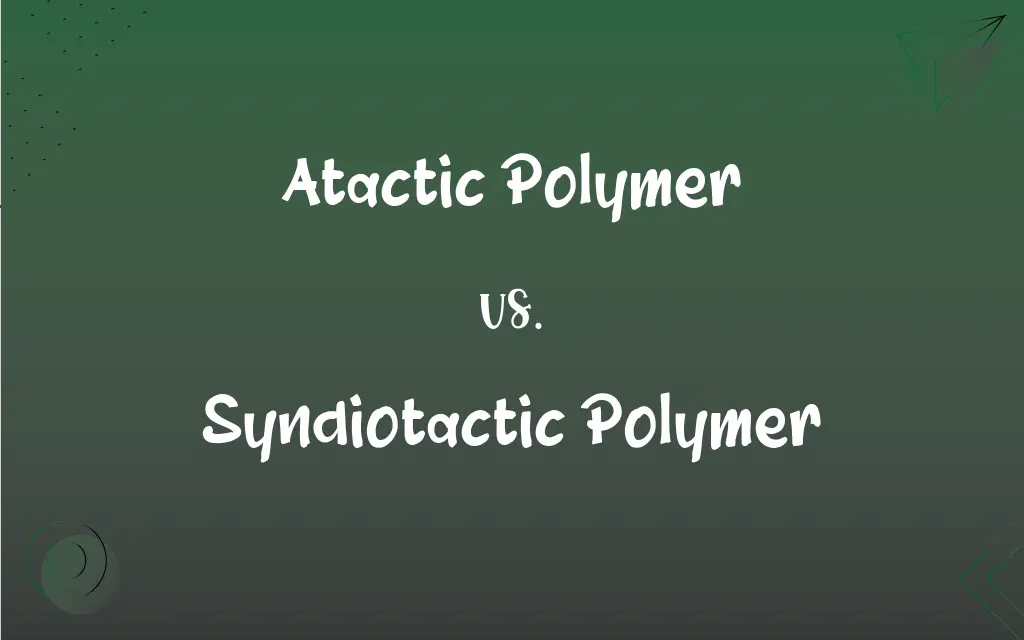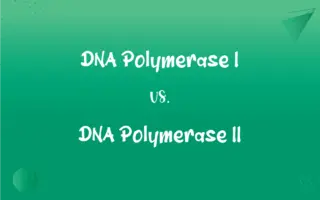Atactic Polymer vs. Syndiotactic Polymer: What's the Difference?
Edited by Aimie Carlson || By Janet White || Published on March 3, 2024
Atactic polymer has random substituent arrangement on its backbone, while syndiotactic polymer has a regular, alternating pattern.

Key Differences
Atactic polymers are characterized by a random configuration of their substituent groups along the polymer chain. This randomness often results in a material with lower crystallinity and strength. In contrast, syndiotactic polymers have a regular and alternating spatial arrangement of substituents, which typically leads to higher crystallinity and strength.
The physical properties of atactic polymers, such as melting point and solubility, are generally inferior due to their irregular structure. Conversely, syndiotactic polymers, with their orderly configuration, exhibit better thermal stability and resistance to solvents.
Atactic polymers tend to be more amorphous due to the random arrangement of side groups, which can lead to materials that are more flexible and less brittle. Syndiotactic polymers, on the other hand, often form semi-crystalline structures that result in materials with higher rigidity and strength.
In terms of processing, atactic polymers often exhibit easier moldability and shaping due to their less ordered structure. Syndiotactic polymers, while offering superior mechanical properties, can be more challenging to process due to their higher crystallinity.
The applications of atactic polymers are typically found in areas where flexibility and ease of processing are important, like adhesives and sealants. Syndiotactic polymers are more suited for applications requiring strength and thermal stability, such as engineering plastics.
ADVERTISEMENT
Comparison Chart
Substituent Arrangement
Random arrangement of side groups
Regular, alternating arrangement
Crystallinity
Generally lower crystallinity
Higher crystallinity
Physical Properties
Lower melting point and solvent resistance
Higher melting point and solvent resistance
Material Characteristics
More flexible and less brittle
More rigid and stronger
Typical Applications
Used in adhesives, sealants
Used in engineering plastics
ADVERTISEMENT
Atactic Polymer and Syndiotactic Polymer Definitions
Atactic Polymer
Atactic polymer is a type of polymer with randomly arranged substituent groups.
The atactic polymer used in this adhesive provides excellent flexibility.
Syndiotactic Polymer
Syndiotactic polymers are used in applications requiring rigidity and durability.
The rigidity of the syndiotactic polymer makes it a preferred choice for automotive parts.
Atactic Polymer
Atactic polymers are amorphous due to their irregular molecular structure.
The atactic polymer's amorphous nature makes it suitable for packaging materials.
Syndiotactic Polymer
Syndiotactic polymers are known for their superior thermal stability.
The excellent thermal stability of this syndiotactic polymer suits it for high-temperature applications.
Atactic Polymer
Atactic polymers are often used in applications requiring material flexibility.
The atactic polymer's flexibility makes it ideal for use in soft rubber products.
Syndiotactic Polymer
Syndiotactic polymer features a regular, alternating pattern of side groups.
The syndiotactic polymer's structure contributes to its high strength.
Atactic Polymer
Atactic polymers typically exhibit lower melting points.
The lower melting point of this atactic polymer facilitates easier processing.
Syndiotactic Polymer
Syndiotactic polymers typically have higher crystallinity and strength.
The high crystallinity of the syndiotactic polymer makes it ideal for load-bearing applications.
Atactic Polymer
Atactic polymers have lower crystallinity, affecting their physical properties.
Due to its lower crystallinity, this atactic polymer has improved moldability.
Syndiotactic Polymer
Syndiotactic polymers often exhibit higher melting points.
The higher melting point of the syndiotactic polymer allows for use in heat-resistant products.
FAQs
What is an atactic polymer?
An atactic polymer is a polymer with randomly arranged substituent groups along its backbone.
Are atactic polymers flexible?
Yes, atactic polymers are generally more flexible due to their amorphous nature.
How does the structure of atactic polymers affect their properties?
The random structure of atactic polymers often results in lower crystallinity and strength.
Where are syndiotactic polymers typically used?
They are commonly used in engineering plastics and applications requiring high strength and heat resistance.
What is a syndiotactic polymer?
A syndiotactic polymer has a regular, alternating spatial arrangement of its substituent groups.
What are common uses of atactic polymers?
Atactic polymers are often used in adhesives, sealants, and flexible packaging materials.
Can syndiotactic polymers withstand high temperatures?
Yes, due to their higher crystallinity, syndiotactic polymers have better thermal stability.
Do atactic polymers have high melting points?
No, atactic polymers generally have lower melting points due to their irregular structure.
What properties do syndiotactic polymers exhibit?
Syndiotactic polymers typically show higher crystallinity, strength, and thermal stability.
How does the crystallinity of syndiotactic polymers affect their properties?
The higher crystallinity of syndiotactic polymers leads to improved strength and thermal stability.
Are syndiotactic polymers rigid or flexible?
Syndiotactic polymers are more rigid and stronger compared to atactic polymers.
What is the crystallinity of atactic polymers?
Atactic polymers have lower crystallinity, contributing to their amorphous nature.
What is the melting point like for syndiotactic polymers?
Syndiotactic polymers typically have higher melting points, suitable for high-temperature applications.
In what applications are atactic polymers undesirable?
Atactic polymers are less suitable for applications requiring high strength and thermal stability.
Why are syndiotactic polymers preferred in engineering applications?
Their high crystallinity and strength make them ideal for demanding engineering applications.
Is processing easier for atactic or syndiotactic polymers?
Atactic polymers are usually easier to process due to their less ordered structure.
Can atactic polymers resist solvents well?
Atactic polymers generally have lower solvent resistance due to their irregular structure.
What is the solvent resistance of syndiotactic polymers?
Syndiotactic polymers exhibit better resistance to solvents, owing to their orderly structure.
How does the irregular structure of atactic polymers affect their use?
It makes them suitable for applications where flexibility and ease of processing are key.
What makes syndiotactic polymers suitable for high-temperature applications?
Their regular molecular structure imparts high thermal stability, making them suitable for such applications.
About Author
Written by
Janet WhiteJanet White has been an esteemed writer and blogger for Difference Wiki. Holding a Master's degree in Science and Medical Journalism from the prestigious Boston University, she has consistently demonstrated her expertise and passion for her field. When she's not immersed in her work, Janet relishes her time exercising, delving into a good book, and cherishing moments with friends and family.
Edited by
Aimie CarlsonAimie Carlson, holding a master's degree in English literature, is a fervent English language enthusiast. She lends her writing talents to Difference Wiki, a prominent website that specializes in comparisons, offering readers insightful analyses that both captivate and inform.































































